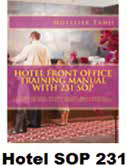Standard Operating Procedure: Guidelines for
Implementation of NABH Standards

Dr. Samina Zamindar
Head, Zamindar’s Microsurgical
Eye Centre, Bengaluru
“A doctor could alternatively be God or a cowboy ruling the hospital by preference or whim, with insufficient consideration for best practices or procedural standardization.”
— Cpt. Sullenberger, July 23, 2010
The first step in your quality journey is making Standard Operating Procedure (SOP) manuals for your  organization, it will be a fact finding exercise which will improve quality at grass root level. A copy paste job done here, will defeat the very purpose of one’s quality improvement journey.
organization, it will be a fact finding exercise which will improve quality at grass root level. A copy paste job done here, will defeat the very purpose of one’s quality improvement journey.
Standard Operating Procedure
It is the fundamental unit for efficient & uniform functioning of any organisation, If a hotel front office manual can have 231 SOP, it goes without saying that it is imperative in any health care organization !
What is an SOP ?
A standard operating procedure (SOP) is a set of written instructions that document a routine or repetitive activity followed by an organization.
Philosophy of SOP
Human beings make mistakes because the systems and processes with which they work are poorly designed, well thought of systems and operating procedures reduces the chance of error.
Where does it belong?
Current copies of the SOPs should be readily accessible for reference in the work areas of those individuals actually performing the activity
HISTORY OF SOP
Military and Army is the first place where documentation made a lot of sense to pass information from one place to another and carry out the activities. Slowly that has been taken into other industries and quality management systems. The Air Force during WWII used SOP’s to get all planes back onto the ground quickly without running into other planes in the pattern. Planes with wounded aboard landed first. Documentation of communication was vital to make any strategy work.
HISTORY OF SOP ISO Standards
Documentation matrix was included in the ISO standards which was generic to all the industries in ISO 9001:2015 the clause 7.5 talks about documentation of information.
The information is divided into two types:
- Unretainable information which is in the minds of staff, and cannot be retained
- Documented information is further divided in to
- Maintained Documentation -What I need- SOP manual
- Retained Documentation- What I have done- Records, reports
Purpose of SOP
- To detail the regularly recurring work processes
- Assist that organization to maintain their quality control and quality assurance processes and ensure compliance.
Benefits of SOP
- Minimizes variation and promotes quality through consistent implementation of a process, even if there are temporary or permanent personnel changes.
- Reduces work effort, easier to pursue people to follow the steps of a task meticulously.
- Improves Comparability, Credibility and Legal defensibility
How do you write it? Sloppily written SOP!!! !
 The process of writing down meticulously, gives structure to your thoughts’ Even better if it is a result of group brainstorming, which will help reduce Mudas(Japanese word for unnecessary steps) from your SOP. If your SOP is clear, crisp, written with use of correct English language, it would carry
The process of writing down meticulously, gives structure to your thoughts’ Even better if it is a result of group brainstorming, which will help reduce Mudas(Japanese word for unnecessary steps) from your SOP. If your SOP is clear, crisp, written with use of correct English language, it would carry  more weight, and the chances that it will be followed meticulously are much higher.
more weight, and the chances that it will be followed meticulously are much higher.
Author
• Written by individuals knowledgeable with the activity and the organization’s internal structure, either individually or as a group brainstorming
• Experts who actually perform the work or use the process.
Who is your target end user of SOP?
• Any Staff who has requisite qualifications for performing an activity, (noted in the section on personnel qualifications in the SOP manual) and is knowledgeable with the general concept, but with limited experience with the procedure. This staff should be able to read the SOP, and perform the given task without supervision. This is the hallmark of a well written SOP.
Content of SOP
• A set of instructions of how to complete an activity.
• Time taken before drafting to focus on exactly what
information is to be conveyed to the user.
Writing Styles keeping in mind your end user
• Written in concise, step-by-step, and easy-to read format.
• Unambiguous
• Simple
• Clearly worded so as to be readily understandable by a person,
• Sufficient detail to carry out the procedure without supervision
Format and language
Drafting tips for SOPs :-
1. Use short, concise sentences.
2. Present one idea at a time whenever possible.
3. Use active voice verbs, read and do the task now
4. Avoid jargon.
5. Use position titles (personal names of individuals).
6. Avoid gender nouns and pronouns whenever possible.
7. Use acronyms only when these are included in the
terms and definitions section.
8. For Mandatory activity, the SOP shall use highly
prescriptive language.
9. Few examples of well written SOP
10. Kindly observe the detailing of SOP in each of them
Examples of a well written SOP
1. SOP for Registration according to ISO 9001-2015 Guidelines process
- 6.1.1.1 Patient approaches Reception staff to avail consultation.
- 6.1.1.2 Reception staff – check with patient whether it is patient’s first visit or subsequent visit.
- 6.1.1.3 If it his/her first visit, enter Patient’s information in HMS and generate the UHID.
- 6.1.1.4 If it is not first visit, find out from patient his or her UHID
- 6.1.1.5 If patient does not have registration number, track the number in HMS with the help of patient’s name or phone number.
- 6.1.1.6 If you cannot find the UHID, give a new UHID to the Patient.
- 6.1.1.7 Direct the patient to the cashier for collection of fees
2. SOP format according to Entry level guidebook available on NABH website
6The details of the name are manually written on patient’s file. For example – Mr Rajesh Kumar, Mr. Harish Bhola etc.Registration staffHMS Software
6The details of the name are manually written on patient’s file. For example – Mr Rajesh Kumar, Mr. Harish Bhola etc.Registration staffHMS Software
| Sl.No. | Standard Operating Process (SOP) | Responsibility | Supporting |
| 1 | Do the OPD registration on first-come first-served basis | Registration staff | HMS software |
| 2 | Enter the following details of the patient from the patient or relative in the HMS Name, age, sex, marital status, address, phone no (mobile/ landline), occupation, drug allergies, E-mail ID. | Registration staff | Registration from General consent slip |
| 3 | Check for referral slip if any and enter in the HMS | Registration staff | HMS Software |
| 4 | It it his/her first visit, enter Patient’s information in HMS and generate a neww UHID. If it is not first visit, find out from patient his or her UHID. | Registration staff | HMS Software |
| 5 | If you cannot find the UHID, five new UHID to the Patient | Registration staff | HMS Software |
SOP Approval
• Head of department or organisation can approve each SOP
• Signature approval indicates that an SOP has been both reviewed and approved by management.This will be the date of implementation of SOP
SOP General Format for details
• Title.
• Purpose
• Qualification and experience of end user
• Abbreviations
• References
• SOP identification (ID) number.
• Version number
• Name of the place, where it belongs
• Date of issue, revision and date o expiry
• Scope-Names of holders/Users of SOP
• Name and signatures of people who authored, reviewed and approved and released the SOP
Frequency of Revisions and Reviews
1. A valid SOP should be reviewed once in 2 years.
2. SOPs need to remain current to be useful. So changed if procedures are changed.
3. Review date should be added to each SOP that has been reviewed.
4. If SOP describes a process that is no longer followed or found faulty, should be withdrawn from the current file and archived by the quality department.
Role of Quality department
• Release
• Filing and administration
• Monitoring implementation Role of quality department-SOP release
• To generate 3 Copies of SOP; the historical, back-up file, third copy will be in the place where it will be used.
• The proper distribution of the SOP, inform potential users that a new SOP has been written. Role of Quality department- filling and administration
• Filing of the original and further copies
• Electronic access can be limited to a read-only format
Role of quality department-SOP release
• To generate 3 Copies of SOP; the historical, back-up file, third copy will be in the place where it will be used.
• The proper distribution of the SOP, inform potential users that a new SOP has been written
Role of Quality department- filling and administration
• Filing of the original and further copies
• Electronic access can be limited to a read-only format, thereby protecting against unauthorized changes made to the document.
• Follow correct protocol for withdrawing SOP across organization when required.
• Superseded versions should be collected and destroyed (except the copy for the historical file) to avoid confusion and unauthorized use.
• To ensure that only officially issued copies may be used, only then the use of the proper instruction is guaranteed.
Role of Quality department – Implementation
• Monitoring implementation of the SOP
• Well written SOP is of no use, if it is not used correctly or its implementation is not ensured
Conclusion
If following things are kept in mind, in the beginning of your SOP journey, it would make your ride less bumpy.
• Philosophy of a step-by-step approach should be adopted
• Keep it as simple as possible
• Must grow by trial and error with increasing experience, by group discussion and with changing perceptions
• Start with Basic operational SOPs
• Filling gaps as practice reveals missing links in the chain of quality assurance
References
• NABH Website-Laxmi memorial hospital documents
• NABH entry level guidebook ISO 9001-2015 guidelines
• United states environmental protection Agency guidance for preparing Standard Operating Procedures (SOPs)
• SOP Manual from Zamindar’s Microsurgical Eye Centre, Bangalore.